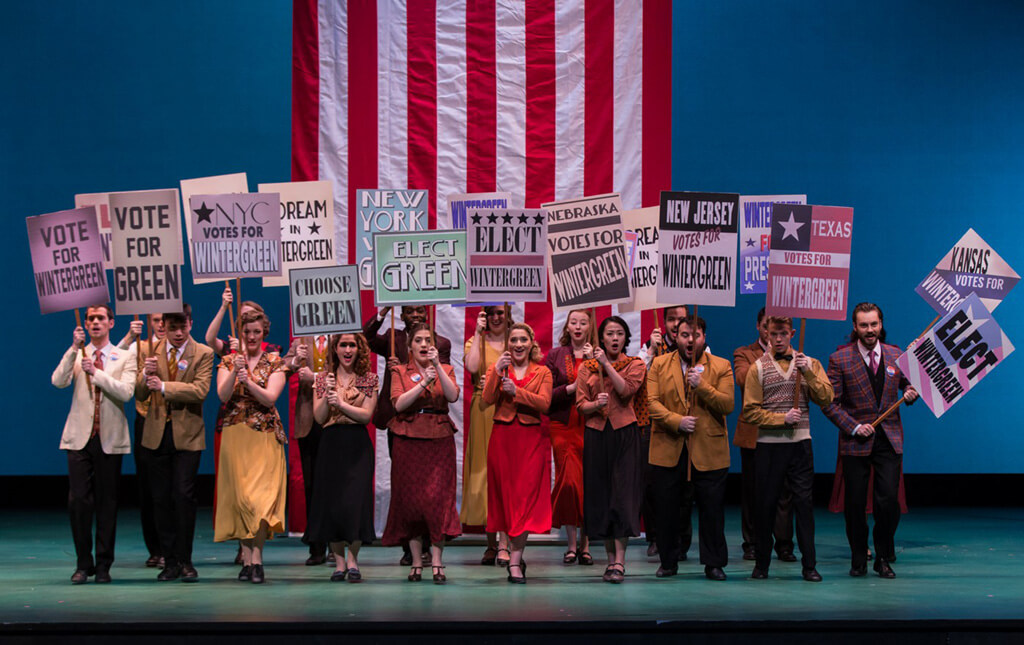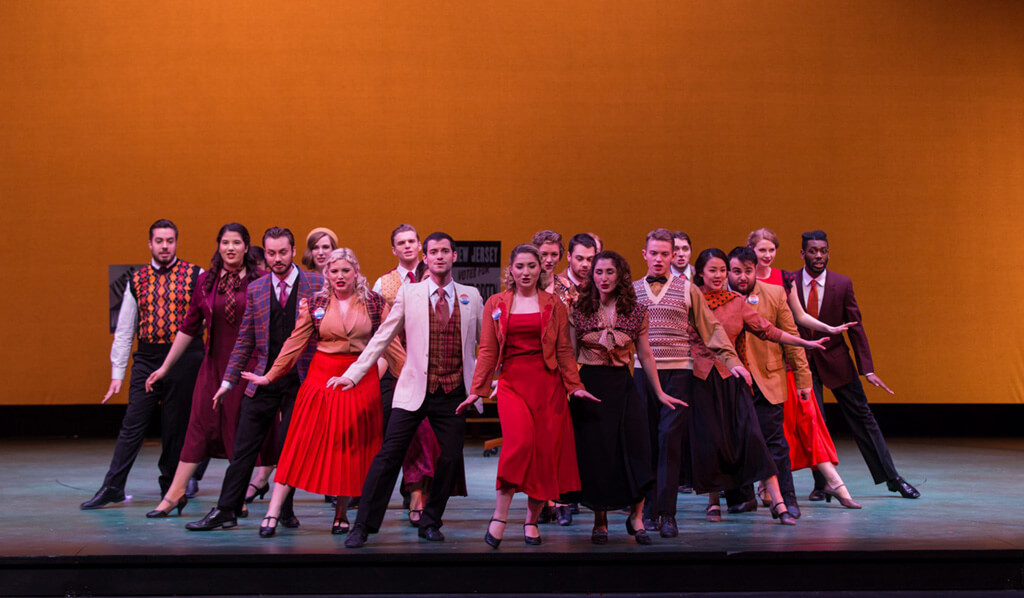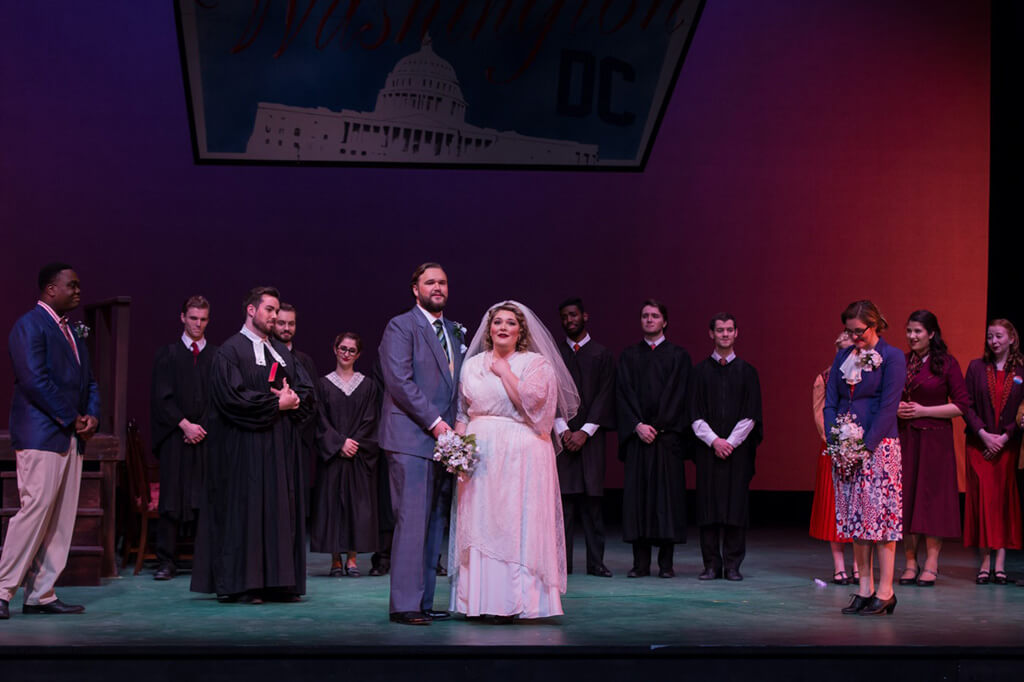
University of Toronto Opera: George Gershwin ‘Of Thee I Sing’ at Edward Johnson Building, Macmillan Theatre. Through Sunday, March 18. Details here.
Despite being a worthy revival of George Gershwin’s rarely performed Broadway musical Of Thee I Sing, it seemed strange to hear The University of Toronto’s opera singers performing musical theatre on the 15th of March in the Macmillan Theatre. I am a big fan of the genres that influenced Gershwin’s style including early music theatre, jazz, and silver age Viennese operetta, but I found myself wondering why this work was chosen to showcase opera students.
While opera companies around the world have been starting to incorporate more and more musical theatre into their seasons to help attract new audiences, the trend offers U of T a chance to train its singers to be better prepared for the opera industry’s rapidly changing landscape. While I think this makes sense, I wonder if Of Thee I Sing might have been a slight push too far away from the genre.
Written by George S. Kaufman and Morrie Ryskind, Of Thee I Sing lampoons a presidential election to make us laugh at and question the corruption and incompetence involved in electing a national leader. The lyrics written by Gershwin’s brother Ira use clever rhymes, much in the style of W.S. Gilbert, to wittily critique the power of media — rather than policy — on political decisions.
A Musical Better Left in Obscurity
In 1932, critics were quick to point Of Thee I Sing’s use of biting satire of American politics, and helped it stand out as the first musical to ever win the Pulitzer Prize for drama. Although Gershwin’s music is a thought-provoking reminder of the use of jazz in Broadway musicals at this time, one can argue that it didn’t live up to the originality acknowledged in the book. Because of its lack of musical novelty, it is not hard to imagine why Of Thee I Sing has fallen into relative obscurity.
While I can understand why UofT might have wanted to revive this not often heard musical, I do not think it was a beneficial choice for their singers. Although director Michael Patrick Albano claimed that because this musical was originally performed unamplified, it can be revived in the same way by opera singers, Gershwin’s musical theatre style already shows the beginning of the Broadway belt seen in the 1930s with singers like Ethel Merman.
This is not to say that the music is bad. In fact, it is very catchy and tuneful, but it requires a different vocal approach than opera. One might argue that opera singers were seen in film, operetta, and on Broadway at this time, but Of thee I Sing was premiered and written for film and stage stars, not opera singers. As a result, I found that Gershwin’s music was not challenging enough and inappropriate for the calibre of student singers at UofT.
A Lesson in Acting and Dance

Having said all this, I can sympathize with Albano’s attempt to use the increased demands of acting, dance, and movement in a musical to challenge the singers to move naturally on stage. These skills are sometimes overlooked in training because opera singers are stereotypically viewed as bodies that stand and sing, which doesn’t cut it in today’s operatic stage. However, I still wonder whether another opera might have been found that combined movement with a score that let the performers show off a bit! I found myself thinking of other 1920’s operettas such as Emmerich Kalman’s Die Zirkusprinzessin or Die Herzogin von Chicago which premiered in English on Broadway at least two years before Of Thee I Sing as stronger options.
A Great Performance by UofT’s Students

While the repertoire didn’t exactly play to the opera program’s strengths, singers Simona Genga and Matthew Cairns did their best to showcase their potential inside Gershwin’s musical scaffold.
As the love interest Mary Turner, Genga surprised me with how naturally she acted, sang, and danced. Although her dark sumptuous voice seemed too refined for Gershwin’s simple vocal lines, she still managed sing and portray the role convincingly. Despite stumbling through some of the dialogue, Cairns made a charismatic presidential candidate John P. Wintergreen with his lyrical rendition of the title song.
Leanne Kaufman stole the show as Rhoda Rosenstein, the New York radio personality, with her sassy accent and charming stage personality. A singer I have known for a long time, Joel Allison, surprised me with his hilarious rendition of the French Ambassador. Allison managed to sing beautifully, impersonate a French (almost Quebecois) accent, and dominate the stage in this small role.
Led by conductor Sandra Horst, the orchestra didn’t seem convinced by the music’s jazzy groove, particularly in the off-beats, which would have highlighted the influence of Paul Whiteman’s big band jazz arrangements on Gershwin’s composition.
Fluidly choreographed by Anna Theodosakis on a rotating stage, the set was sparse to accommodate large dance numbers fully committed to the energetic big Broadway choreography.
Is it Time Yet For a Trump Opera?
Given today’s political climate, it will come as no surprise that a show depicting the president as an incompetent and unfocused celebrity provoked the audience to laugh several times. No one could miss the significance when Wintergreen says “who cares about the electoral college” in response to the votes being tallied. Who would’ve thought a piece written in the early 20th-century could be so prescient? Although Albano mentioned that he and Horst chose a traditional set despite these current resonances, I can’t help but think that they missed an opportunity to explore and inspire their students to make this relatively unknown work relevant to their own generation.
Correction: March 18, 2018, 10:30 a.m. A previous version incorrectly stated choreography was by Anna Theodosakis and Karine White. Karine White was not involved in this production.



